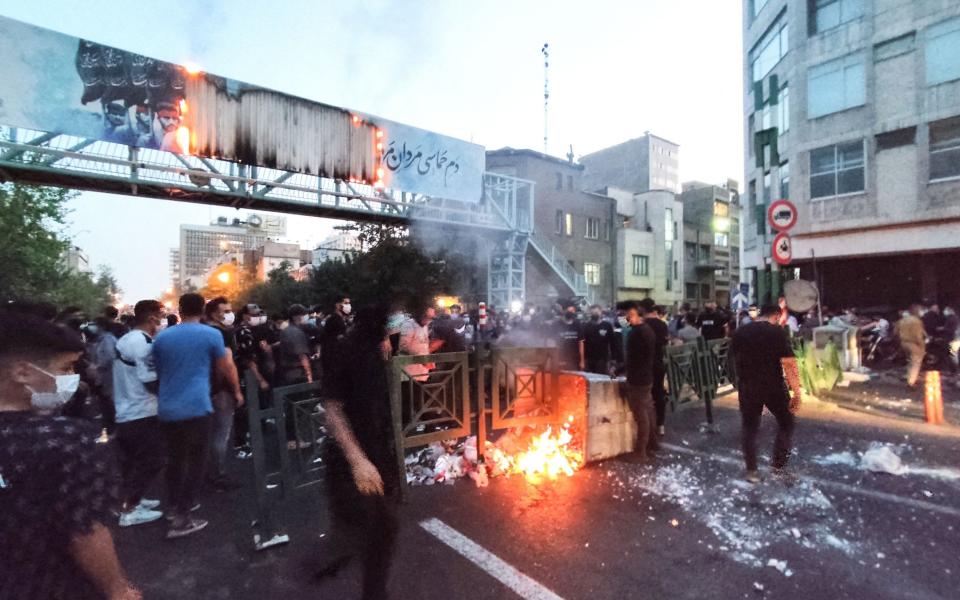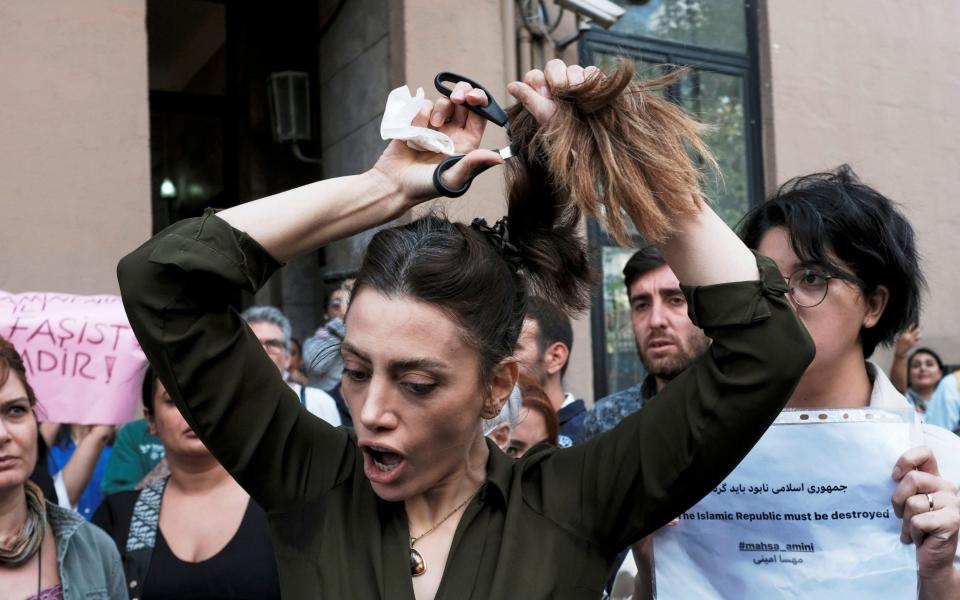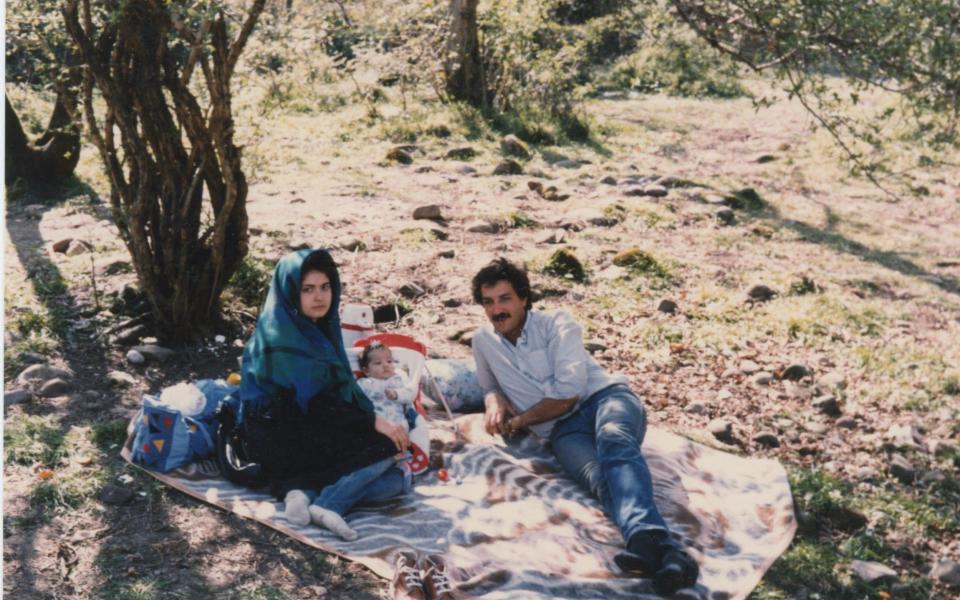‘If an innocent young woman can be so swiftly killed by the Iranian state, no woman is safe’

- Oops!Something went wrong.Please try again later.
Bonfires fuelled by head scarves. Girls, dancing in public as if they were allowed, chant "woman, life, freedom". Some publicly cut their hair as furious crowds call for the fall of Supreme Leader Ayatollah Ali Khamenei. Chaos may have spread to the four corners of Iran, but one thing is certain: history is being made right now.
Speaking to my friends and family back in Iran, they have many different stories of what they’ve witnessed over the past few days. During the day, there is calm. Many choose not to leave their house once evening comes, for fear of being mistaken as dissidents. For those that do venture out, beatings are commonplace, as is the sting of tear gas and the sound of bullets. Friends of friends are directly caught up in the violence: a yoga instructor, detained; an art director in hospital.
In fact, according to state media reports, at least 76 people have been killed in the 11 days of the demonstrations. Human rights groups warn the actual figure is far higher. But to Iranians, women’s hair no longer has the same meaning. For so long, our beautiful, thick locks have been intertwined with religion and politics. Now, our hair means life, freedom and, for those who dare flaunt it, death.
Mahsa Amini took her last trip on Tehran’s subway system on Tuesday 13 September. Stepping out into the warm late-summer sun, she caught the eye of a nearby patrol of the so-called morality police. Though wearing a hijab - a headscarf - as is required by law, it appears the manner in which she wore it was unsatisfactory enough for the patrol to bundle her into a van and send her off to a detention centre for “re-education”. On Friday 16th, Mahsa died in hospital, having lain in a coma for three days.
The official statement says she died from a “sudden heart failure”. Mahsa’s family, on the other hand, say she had no underlying health complaints and claim she was ultimately killed by beatings administered by the police. The authorities deny any mistreatment. This, the death of a healthy young woman following a period in custody, is what sparked the riots.

Hatred for the mandatory wearing of the hijab is nothing new among Persian women. But recently, the current hardline prime minister, Ibrahim Raisi, has been fanning the flames of discontent with a raft of restrictions, the most draconian of which include the use of surveillance cameras to digitally capture women failing to cover their hair. In reaction to this, there was an increase in women posting pictures of themselves without hijab on social media; a trend which has only increased since Mahsa’s death.
A general contempt for their ultra-conservative government’s increasing curtailment of freedoms, alongside dissatisfaction with the country’s failing economic situation, can explain why these protests are so widespread. The reason behind the depth of fury, however, is more difficult to explain: perhaps it comes down to the millions of would-be Mahsa’s that fill Iran’s offices, universities and coffee shops. If an ordinary, innocent young woman can be so swiftly disappeared and killed by the state, then no woman is safe. I suppose this has always been known. But now, in the age of social media, it is being seen and felt like never before.
Regardless of religion or nationality, in Iran, all women and girls above the age of nine, must comply with the Islamic dress code imposed by the regime: hair should be covered and garments must be loose-fitting. In order to cover their hair, women predominantly wear a hijab; an item of clothing that became compulsory soon after the emergence of the Islamic Republic in 1979, and exists as a daily physical reminder of both the regime’s resistance to reform and its obsession with our bodies.

In charge of enforcing the laws on Islamic dress code are the so-called morality police. The dress code is problematic as the lack of specification leaves a large gap for interpretation and the arbitrary enforcement of the laws. What is definite is that women can be fined or imprisoned for wearing clothes in a manner deemed inappropriate. Iranian laws are also hugely discriminatory against women in almost all aspects of their lives, including inheritance, marriage and divorce, child custody and even travel.
It wasn’t always this way. The Shah, Mohammed Reza Pahlavi, took over Iran from his exiled father in 1941 and oversaw a period of political maturation, strengthening of ties with the West, and domestic reform policies that included the eradication of illiteracy and extending voting rights to women in 1963. Photos of Tehran from this period bear more resemblance to London in the swinging Sixties to the Iran we see today. Women gather together in colourful skirts and fitted blouses, their legs bare and heads unadorned, except with modish sunglasses and large earrings.
But the influence of British, Soviet and American powers over Iran and its vast oil supply was a constant source of anger and shame. Coupled with the Shah’s suppression of opposing voices, unrest was never too distant a prospect. The exiled cleric Khomeini harnessed a wave of nationalistic fury and announced his vision of an apparently more democratic, albeit religious, rule of Iran and returned home on 1 February 1979. Within weeks, supporters of the Shah had been executed, and by March, a new government had been voted in by 98 per cent of the population. Of course, only one option had been present on the ballot: The Islamic Republic. Many of the laws created at this time focused on how the state could control women’s careers, bodies and even their appearance. It took only until the summer of 1983 for the hijab to be declared mandatory for all women.
I was born in the Islamic Republic of Iran, 10 years after the Revolution. I spent my first 12 years there, until, along with my mother and baby sister, we were forced to escape the country to avoid political persecution attracted by my father’s anti-regime activism.

My parents grew up in affluent families during the golden economic era of the Shah’s reign and struggled with the ever-growing restrictions after the Revolution. They had both intended to find a way out of the country, long before they met and fell in love. But there was no money; their families had lost everything post-revolution. So, like many other Iranians, they had no choice but to live a double life; the threshold of their home became the gateway between worlds. I recall my dad saying at a party, “Before the Revolution, we used to pray at home and drink booze outside. But now, we drink indoors and pray outside.” I witnessed this duality on a daily basis.
Even as an eight-year-old girl, the shame and fear was ever-present. As a reward for getting good grades in school, my mum took me to Tehran’s funfair. I still remember the excitement as we were approaching the gates when security stopped us. The problem was not our tickets; it was my hair. “But she’s still underaged,” my pregnant mum argued desperately, “she still has one year left before having to cover up.” The security guard argued that I looked older, and in danger of “god forbid, providing sin.” I can still feel the lump in my throat as we walked away, the excited screams of the other children floating above my uncovered, sinful head. Wherever I turned, it felt like a battleground, and my only way out was to make myself invisible, hiding under layers. Though my mum, and other women around me, were hiding it as best as they could, I could sense their fury and hopelessness.
But now, nearly 40 years since the hijab was enforced, my countrywomen have had enough of this control. Shockingly, billboards of both past and present supreme leaders are being burnt, lighting the faces of protestors as they gather at nightfall. The police, who cluster in groups at the end of each street, are aided by the Basijis, a hardcore teenage militia who dole out beatings on a whim. Opposing them are their former schoolmates, young Iranian Gen Zs, who wield smartphones as a defence against the state’s censorship. The state has shut down the internet in Tehran but the notorious hacker collective known as ‘Anonymous’ are aiding protestors from the outside, helping with evermore secure VPNs so that footage can be posted online and, fantastically, interrupting a state TV broadcast of a football match with scenes of the protests themselves.

Whether this is a movement that can change everything, or at the very least lead to the abolition of mandatory hijab, only time can tell. In 2010, the Arab Spring swept across swathes of the Arab world and lasting reform seemed like a plausible outcome. Yet, while some of those nations have witnessed minor economic and social improvements, data shows internet and press freedom has been curtailed, arguably leaving inhabitants in a worse situation than before. Personally, I don’t feel that optimistic about these street protests changing much in the immediate future; aside from the sheer naked rage of Iranian women, the movement is without organisation; without a leader.
But one thing is clear; Iranians have shown the world that they are deeply discontent. They have bravely crossed lines that seemed unpassable. Iranian women, just like every other human in the world, deserve bodily autonomy; now they are demanding it.
This movement is a multi-generational one yet, it’s young people who are being killed in the current wave of the protests, and if the international community doesn't take action, more will die.
Journalist and activist Masih Alinejad, creator of the #mystealthyfreedom movement, has suggested that the UK government could, among other actions, join the US State Department in imposing travel sanctions on those responsible for the attacks on protestors; expel Seyed Hashem Moosavi, the official representative of Ali Khamenei in the UK; and issue sanctions waivers for tech companies that could help Iranians maintain access to the internet. In our age of digital interaction, this last suggestion would certainly be felt most immediately, and most keenly, by the millions of Iranians who need their stories to be seen.
And the regime knows that the world is watching.
